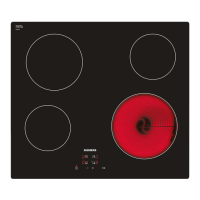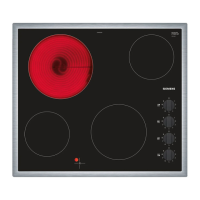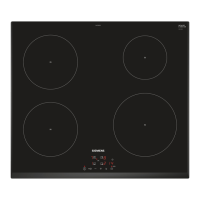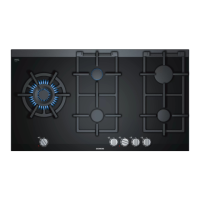en Operating the appliance
6
Setting a hotplate
Use the + and - symbols to set the desired heat setting.
Heat setting 1 = lowest setting
Heat setting 9 = highest setting
There is an intermediate setting between each heat
setting. This is identified by a dot.
Setting the heat setting
The hob must be switched on.
1. Touch the μ symbol to select the hotplate. ‹ lights
up on the heat setting display.
2. Touch the + or - symbol within the next 10 seconds.
The basic setting appears.
+ symbol: Heat setting 9
- symbol: Heat setting 4
3. To change the heat setting: Touch the + or - symbol
until the desired heat setting appears.
Switching off the hotplate
There are 2 ways to switch off the hotplate:
■ Briefly touch the μ symbol on the hotplate 2x one
after the other. ‹ appears in the heat setting display.
After about 10 seconds, the residual heat indicator
appears.
■ Use the μ symbol to select the hotplate. Touch the
+ or - symbol until ‹ appears. After about
10 seconds, the residual heat indicator appears.
Notes
■ The last selected hotplate remains activated. You
can adjust the hotplate without selecting it again.
■ Hotplate temperature is regulated by the heat
switching on and off.The heat may also switch on
and off at the highest setting.
This ensures e.g.:
– sensitive components are protected from
overheating
– the appliance is protected from electrical
overload
– better cooking results are achieved
Table of cooking times
The following table provides some examples.
Cooking times and heat settings may vary depending
on the type of food, its weight and quality. Deviations
are therefore possible.
For bringing liquids to the boil, use heat setting 9.
Stir thick liquids occasionally.
Food that needs to be seared quickly or food which
loses a lot of liquid during initial frying is best seared in
several small portions.
Tips for energy-saving cooking can be found in the
Environmental protection section.~ Page 4
Ongoing
cooking set-
ting
Ongoing cook-
ing time in min-
utes
Melting
Chocolate coating 1-1. -
Butter, honey, gelatine 1-2 -
Heating and keeping warm
Stew (e.g. lentil stew) 1-2 -
Milk** 1.-2. -
Heating sausages in water** 3-4 -
Defrosting and heating
Frozen spinach 2.-3. 10-20 min
Frozen goulash 2.-3. 20-30 min
Poaching, simmering
Dumplings 4.-5.* 20-30 min
Fish 4-5* 10-15 min
White sauces, e.g. béchamel
sauce
1-2 3-6 min
Whisked sauces, e.g. sauce Béar-
naise, hollandaise
3-4 8-12 min
Boiling, steaming, braising
Rice (with double the quantity of
water)
2-3 15-30 min
Rice pudding 1.-2. 35-45 min
Unpeeled boiled potatoes 4-5 25-30 min
Boiled potatoes 4-5 15-25 min
Pasta, noodles 6-7* 6-10 min
Stew, soups 3.-4. 15-60 min
Vegetables 2.-3. 10-20 min
Frozen vegetables 3.-4. 10-20 min
Cooking in a pressure cooker 4-5 -
Braising
Roulades 4-5 50-60 min
Pot roast 4-5 60-100 min
Goulash 2.-3. 50-60 min
Frying with little oil**
Escalope, plain or breaded 6-7 6-10 min
Escalope, frozen 6-7 8-12 min
Chop, plain or breaded*** 6-7 8-12 min
Steak (3 cm thick) 7-8 8-12 min
* Ongoing cooking without a lid
** Without lid
*** Turn frequently

